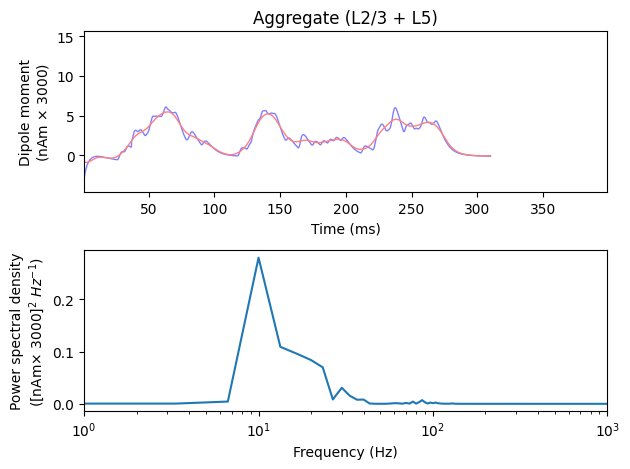5.2 API Tutorial of Alpha/Beta Rhythms
This example demonstrates how to simulate alpha and beta frequency activity in the alpha/beta complex of the SI mu-rhythm [1]_, as detailed in the HNN GUI alpha and beta tutorial, using HNN-Core.
We recommend you first review the GUI tutorial. The workflow below recreates the alpha only rhythm, similar to Figure 5 of the GUI tutorial, and the alpha/beta complex similar to Figure 20 in the GUI tutorial, albeit without visualization of the corresponding time-frequency spectrograms [1]_.
# Authors: Mainak Jas
# Sam Neymotin
# Nick Tolley
# Christopher Bailey
import os.path as op
Let us import hnn_core
import hnn_core
from hnn_core import simulate_dipole, jones_2009_model
Now let's simulate the dipole and plot it. To excite the network, we
add a ~10 Hz "bursty" drive starting at 50 ms and continuing to the end
of the simulation. Each burst consists of a pair (2) of spikes, spaced
10 ms apart. The occurrence of each burst is jittered by a random,
normally distributed amount (20 ms standard deviation). We repeat the
burst train 10 times, each time with unique randomization. The drive is
only connected to the :term:proximal (dendritic) AMPA
synapses on L2/3 and L5 pyramidal neurons.
net = jones_2009_model()
location = 'proximal'
burst_std = 20
weights_ampa_p = {'L2_pyramidal': 5.4e-5, 'L5_pyramidal': 5.4e-5}
syn_delays_p = {'L2_pyramidal': 0.1, 'L5_pyramidal': 1.}
net.add_bursty_drive(
'alpha_prox', tstart=50., burst_rate=10, burst_std=burst_std, numspikes=2,
spike_isi=10, n_drive_cells=10, location=location,
weights_ampa=weights_ampa_p, synaptic_delays=syn_delays_p, event_seed=284)
# simulate the dipole, but do not automatically scale or smooth the result
dpl = simulate_dipole(net, tstop=310., n_trials=1)
trial_idx = 0 # single trial simulated, choose the first index
# to emulate a larger patch of cortex, we can apply a simple scaling factor
dpl[trial_idx].scale(3000)
Prior to plotting, we can choose to smooth the dipole waveform (note
that the :meth:~hnn_core.dipole.smooth-method operates
in-place, i.e., it alters the data inside the
Dipole object). Smoothing approximates the effect of signal
summation from a larger number and greater volume of neurons than are
included in our biophysical model. We can confirm that what we simulate
is indeed 10 Hz activity by plotting the power spectral density
(PSD).
import matplotlib.pyplot as plt
from hnn_core.viz import plot_dipole, plot_psd
fig, axes = plt.subplots(2, 1, constrained_layout=True)
tmin, tmax = 10, 300 # exclude the initial burn-in period from the plots
# We'll make a copy of the dipole before smoothing in order to compare
window_len = 20 # convolve with a 20 ms-long Hamming window
dpl_smooth = dpl[trial_idx].copy().smooth(window_len)
# Overlay the traces for comparison. The function plot_dipole can plot a list
# of dipoles at once
dpl[trial_idx].plot(tmin=tmin, tmax=tmax, color='b', ax=axes[0], show=False)
dpl_smooth.plot(tmin=tmin, tmax=tmax, color='r', ax=axes[0], show=False)
axes[0].set_xlim((1, 399))
plot_psd(dpl[trial_idx], fmin=1., fmax=1e3, tmin=tmin, ax=axes[1], show=False)
axes[1].set_xscale('log')
plt.tight_layout()
plt.show()

The next step is to add a simultaneous 10 Hz
:term:distal drive with a lower within-burst spread of
spike times (burst_std) compared with the proximal one. The
different arrival times of spikes at opposite ends of the pyramidal
cells will tend to produce bursts of 15-30 Hz power known as beta
frequency events.
location = 'distal'
burst_std = 15
weights_ampa_d = {'L2_pyramidal': 5.4e-5, 'L5_pyramidal': 5.4e-5}
syn_delays_d = {'L2_pyramidal': 5., 'L5_pyramidal': 5.}
net.add_bursty_drive(
'alpha_dist', tstart=50., burst_rate=10, burst_std=burst_std, numspikes=2,
spike_isi=10, n_drive_cells=10, location=location,
weights_ampa=weights_ampa_d, synaptic_delays=syn_delays_d, event_seed=296)
dpl = simulate_dipole(net, tstop=310., n_trials=1)
We can verify that beta frequency activity was produced by inspecting the PSD of the most recent simulation. The dominant power in the signal is shifted from alpha (~10 Hz) to beta (15-25 Hz) frequency range. All plotting and smoothing parameters are as above, but here no scaling is applied, leading to smaller absolute values in the plots.
fig, axes = plt.subplots(3, 1, constrained_layout=True)
net.cell_response.plot_spikes_hist(ax=axes[0], show=False)
# We'll again make a copy of the dipole before smoothing
smooth_dpl = dpl[trial_idx].copy().smooth(window_len)
# Note that using the ``plot_*``-functions are available as ``Dipole``-methods:
dpl[trial_idx].plot(tmin=tmin, tmax=tmax, ax=axes[1], color='b', show=False)
smooth_dpl.plot(tmin=tmin, tmax=tmax, ax=axes[1], color='r', show=False)
dpl[trial_idx].plot_psd(fmin=0., fmax=40., tmin=tmin, ax=axes[2], show=False)
plt.tight_layout()
plt.show()

References
[1] Jones, S. R. et al. Quantitative analysis and biophysically realistic neural modeling of the MEG mu rhythm: rhythmogenesis and modulation of sensory-evoked responses. J. Neurophysiol. 102, 3554–3572 (2009).
